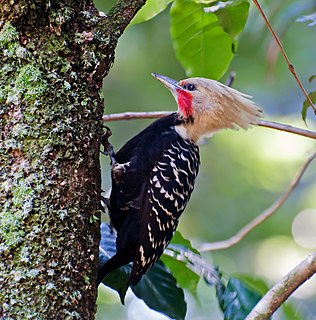
The blond-crested woodpecker is a species of bird in the family Picidae, the woodpeckers, piculets and wrynecks. It is found in Brazil, southeastern Paraguay, and extreme northeastern Argentina. A small disjunct population occurs at the Amazon River mouth and upstream, including the southern part of Ilha de Marajo. The ochre-backed woodpecker is sometimes considered a subspecies. Its natural habitats are subtropical or tropical moist lowland forests, subtropical or tropical dry shrubland, and heavily degraded former forest.
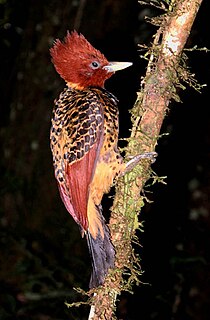
The rufous-headed woodpecker is a species of bird in the family Picidae. It formerly included Kaempfer's woodpecker as a subspecies.

The rufous-bellied woodpecker or rufous-bellied sapsucker is a species of bird in the family Picidae. This woodpecker has a habit of making a series of small pits on the bark of trees leading to its being considered an Asiatic member of the sapsuckers in the past. It is found along the Himalayas in the Indian subcontinent and Southeast Asia, ranging across Bangladesh, Bhutan, Cambodia, Hong Kong, India, Korea, Myanmar, Nepal, Thailand, Manchuria, Ussuriland and Vietnam. Its natural habitats are subtropical or tropical moist lowland forests and subtropical or tropical moist montane forests.

The grey-and-buff woodpecker is a species of bird in the family Picidae. It is found in Brunei, Indonesia, Malaysia, southern Myanmar, and southern Thailand, but has become regionally extinct in Singapore. Its natural habitats are lowland and montane tropical or subtropical moist broadleaf forests.

The white-wedged piculet is a species of bird in the family Picidae. It is found in Bolivia, Brazil and Paraguay, where its natural habitats are subtropical or tropical dry forests, subtropical or tropical moist lowland forests, and dry savannah. It hybridizes with the white-barred piculet where their ranges overlap.
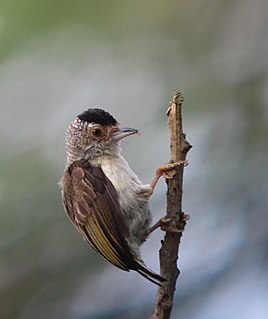
The plain-breasted piculet is a species of bird in the woodpecker family. It is found in the Ucayali and Amazon floodplains in eastern Peru. Its natural habitats are subtropical or tropical moist lowland forests and heavily degraded former forest.
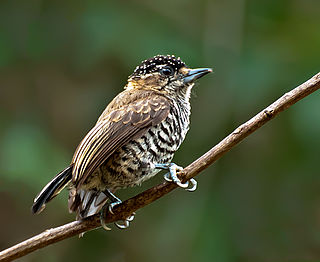
The white-barred piculet is a species of bird in the family Picidae, the woodpeckers, piculets, and wrynecks. It is found in south-eastern Brazil south and west to the Pantanal, and into south-eastern Bolivia, Paraguay and northern Argentina. A disjunct population occurs in the coastal parts of French Guiana, south to the Brazilian state of Amapá and west along the lower Amazon River up to around the Tapajós River. A small, apparently isolated population is found in southern Guyana and adjacent Roraima. Its natural habitats are subtropical or tropical dry forests, subtropical or tropical moist lowland forests, and heavily degraded former forest.

The ocellated piculet is a species of bird in the family Picidae. It is found in Argentina, Bolivia, and Peru. Its natural habitats are subtropical or tropical moist montane forests and heavily degraded former forest. It was first described in 1845 as Picumnus d’Orbignyanus by the French ornithologist Frédéric de Lafresnaye, being named in honour of the French naturalist Alcide d'Orbigny, but since then has been largely mis-spelt as P. dorbygnianus. It hybridizes with the white-barred piculet where their ranges overlap.

The mottled piculet is a species of bird in the family Picidae. It is found in north eastern Argentina, south eastern Brazil, and Uruguay. Its natural habitat is subtropical or tropical moist lowland forests. It is becoming rare due to habitat loss.
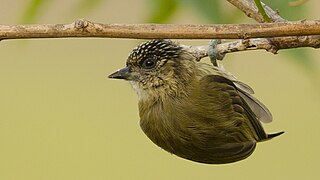
The olivaceous piculet is a species of bird in the family Picidae. Etymologically, piculet is as a double diminutive of the Latin picus, woodpecker, see also Picus. In Greek, δρύοψ is woodpecker, which shares its roots with δρῦς, 'tree'; 'oak' and Druids.

The Orinoco piculet is a species of bird in the family Picidae. It is found in Brazil, Colombia, and Venezuela. Its natural habitat is subtropical or tropical moist lowland forests.

The scaled piculet is a species of bird in the woodpecker family Picidae. It is found in Colombia and Venezuela. Its natural habitats are subtropical or tropical dry forests, subtropical or tropical moist lowland forests, and heavily degraded former forest. This bird was first described by the French naturalist Frédéric de Lafresnaye in 1854; five subspecies are recognised.

The speckle-chested piculet is a species of bird in the family Picidae (woodpeckers) endemic to Peru. Its natural habitats are tropical moist lowland and montane forests. It is threatened by habitat destruction as the forests are cleared to make way for agricultural land, and the IUCN has rated it as being an endangered species.

The ochre-collared piculet is a species of bird in the family Picidae. It is found in Argentina, Brazil, and Paraguay. Its natural habitats are subtropical or tropical moist lowland forest, subtropical or tropical dry shrubland, and heavily degraded former forest.

The varzea piculet is a species of bird in the family Picidae, the woodpeckers, piculets, and wrynecks. It is endemic to Brazil's Amazon basin where it occurs in seasonally flooded Várzea forests, which gives the bird its common name. Its natural habitat is tropical moist lowland forest, and as the trees are progressively being cleared in the Amazon basin, the population of the bird is declining, and as a consequence, the International Union for Conservation of Nature has rated it as an "endangered species".

The banded woodpecker or the banded red woodpecker is a species of bird in the family Picidae. It is found in Brunei, Indonesia, Malaysia, Myanmar, Singapore, and Thailand. Its natural habitats are subtropical or tropical moist lowland forests and subtropical or tropical mangrove forests.
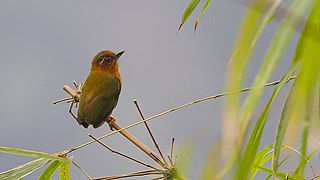
The white-browed piculet is a species of bird in the family Picidae. It is found in Bangladesh, Bhutan, Cambodia, India, Laos, Myanmar, Nepal, Thailand, and Vietnam. Its natural habitats are temperate forests and subtropical or tropical moist montane forests.

The scarlet-backed woodpecker is a species of bird in the family Picidae. It is found in Colombia, Ecuador and northern Peru where its natural habitats are subtropical or tropical dry forests and subtropical or tropical dry shrubland. It is listed by the International Union for Conservation of Nature as being a species of "least concern".

The blood-colored woodpecker is a species of bird in the family Picidae, the woodpeckers, piculets, and wrynecks. It is found only in the Guianan countries of Guyana, Suriname, and French Guiana, on the Atlantic shoreline region in a narrow coastal strip, 140–180 km wide. Its natural habitats are subtropical or tropical moist lowland forests, subtropical or tropical mangrove forests, and heavily degraded former forest. It is a fairly common species with a restricted range, but the population seems stable and the International Union for Conservation of Nature has assessed its conservation status as being of "least concern".

Picumnus is a large genus of piculets. With a total length of 8–10 cm (3–4 in), they are among the smallest birds in the woodpecker family.



















